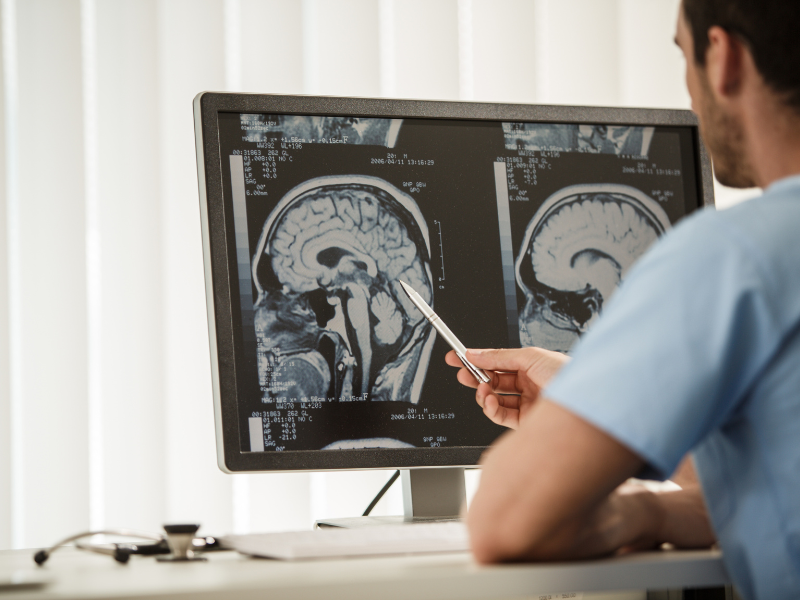在不遠的將來,憂鬱症評估可能會包括一次快速的腦部掃描,以確定最佳治療方法。
這項創新源於今年六月,史丹佛醫學院於《自然醫學》發表的重要研究成果:透過腦部成像結合機器學習可以辨認不同憂鬱症的亞型(又稱生物型),並有可能預測哪些類型的治療最有效。
憂鬱症治療也需要對症下藥
在美國,近五分之一的憂鬱症患者沒有得到正確的診斷。這意味著數以百萬計的人可能正在接受無效或不適當的治療。而約 30% 的患者為所謂的難治性憂鬱症,這意味著多種藥物或療法都未能改善他們的症狀。而對於多達三分之二的憂鬱症患者來說,治療無法完全將他們的症狀恢復到健康水平。
這部分是因為沒有好的方法來知道哪種抗憂鬱藥或療法可以幫助特定患者。醫生們常常需要反覆試驗不同的藥物,直到找到有效的那個。這個過程不僅耗時耗力,還可能加重患者的痛苦。
領導此研究的史丹佛醫學院精準心理健康和健康中心主任 Leanne Williams 博士,因個人經歷深知這一挑戰之嚴重性。她在 2015 年因為憂鬱症失去了伴侶,這促使她致力投身於精準精神病學領域(precision psychiatry),期望能找到更有效的憂鬱症治療法。
「我們工作的目標是弄清楚如何第一次就做對。在憂鬱症領域工作卻沒有比這種一刀切方法更好的選擇,這很令人沮喪。」她說。

研究團隊使用了一種叫做功能性磁共振成像(fMRI)的技術來掃描801位憂鬱症或焦慮症患者的大腦。研究人員特別關注與憂鬱症相關的大腦區域,如杏仁核、下丘腦、海馬體和前額葉皮層,以及這些區域之間的連接(稱為迴路),並觀察觀察了患者在休息時和執行特定任務時,以及投放三種最常開的抗憂鬱藥物和心理治療後,所展現的大腦活動。
辨別出六種憂鬱症類型 開啟精準個性化治療
研究以特定大腦迴路功能障礙,劃分出六種不同的憂鬱症類型,各自應對有效的治療方式也有所區別。目前發現的六種亞型(subtype)對照其受損的迴路如下:
- 預設模式迴路:影響內部心理過程,如思想徘徊和內省。
- 顯著性迴路:可能導致焦慮的身體症狀和壓倒性的感官體驗。
- 積極影響迴路:影響體驗快樂、獎勵和動機的能力。
- 負面影響迴路:影響處理負面情緒的能力。
- 注意力迴路:影響維持注意力和集中注意力的能力。
-
認知控制迴路:影響執行功能,如工作記憶和計劃。
這項研究揭示了情緒障礙的複雜性,並為我們理解情緒低落的原因提供的新視角。而不同類型的憂鬱症需要不同的治療方法,就好比有些交通堵塞需要修建新的道路,而有些只需要優化紅綠燈的時間設置;某些類型的患者對特定的抗憂鬱藥特別有效,而另一些類型則可能從心理治療中獲益更多。
透過腦部成像來判斷憂鬱症的類型,能夠幫助醫生迅速找到問題的根源,減少試錯過程,為患者制定更精準、個性化的治療計劃。
研究的局限與展望
然而,就像所有的突破性研究一樣,這項工作也面臨著挑戰。首先,研究參與者主要是白人,未來需要在更多樣化的人群中進行進一步研究。其次,fMRI設備昂貴且稀少,目前只在少數大型醫療中心可用,而保險公司可能不願意為這種新型診斷方法買單,除非有更多證據證明其有效性。此外,截至目前只研究了三種抗憂鬱藥和有限數量的心理療法,未來需要納入更多已建立的治療方法。

儘管存在這些局限性,但許多專家認為這項研究代表了精神病學領域的一個重要進步。
研究團隊成員Laura Hack博士,已經開始在史丹佛醫學院的臨床實踐中使用這種成像技術。該團隊希望為該方法建立易於遵循的標準化流程,以便其他執業精神病學家也能實施這項新療法。
這項研究為未來開發更精確、更有效的憂鬱症治療方法提供了希望。雖然還需要更多的研究和驗證,但它無疑為我們理解和治療這種複雜的疾病開闢了新道路,為無數憂鬱症患者帶來了康復的希望。

Stanford Medicine Discovers Six Distinct Biotypes of Depression!
In the near future, depression assessments may include a quick brain scan to determine the best treatment method.
This innovation stems from a significant research finding published in Nature Medicine this June by Stanford Medical School: brain imaging combined with machine learning can identify different subtypes (also known as biotypes) of depression and potentially predict which types of treatment will be most effective.
Depression Treatment Needs to be Tailored
In the United States, nearly one-fifth of depression patients are not correctly diagnosed. This means millions of people may be receiving ineffective or inappropriate treatment. About 30% of patients have what's called treatment-resistant depression, meaning multiple medications or therapies have failed to improve their symptoms. For up to two-thirds of depression patients, treatment fails to fully restore their symptoms to healthy levels.
This is partly because there's no good way to know which antidepressant or therapy can help a specific patient. Doctors often need to try different medications repeatedly until they find an effective one. This process is not only time-consuming and labor-intensive but may also exacerbate the patient's suffering.
Dr. Leanne Williams, who led this research and is the director of Stanford Medical School's Precision Mental Health and Wellness Center, knows the severity of this challenge from personal experience. She lost her partner to depression in 2015, which motivated her to dedicate herself to the field of precision psychiatry, hoping to find more effective depression treatments.
"Our goal is to figure out how to get it right the first time. It's very frustrating to work in the field of depression and not have a better alternative to this one-size-fits-all approach," she says.

The research team used a technique called functional magnetic resonance imaging (fMRI) to scan the brains of 801 patients with depression or anxiety. Researchers focused on brain regions associated with depression, such as the amygdala, hypothalamus, hippocampus, and prefrontal cortex, as well as the connections between these areas (called circuits). They observed brain activity in patients at rest, while performing specific tasks, and after administering three commonly prescribed antidepressants and psychotherapy.
Identifying Six Types of Depression Opens the Door to Precision Personalized Treatment
The study identified six different types of depression based on specific brain circuit dysfunctions, each responding differently to various treatment approaches. The six subtypes and their affected circuits are as follows:
- Default Mode Network: Affects internal mental processes, such as mind-wandering and introspection.
- Salience Network: May lead to anxious physical symptoms and overwhelming sensory experiences.
- Positive Affect Network: Influences the ability to experience pleasure, rewards, and motivation.
- Negative Affect Network: Affects the ability to process negative emotions.
- Attention Network: Impacts the ability to maintain and focus attention.
- Cognitive Control Network: Influences executive functions, such as working memory and planning.
This research reveals the complexity of emotional disorders and provides a new perspective on understanding the causes of low mood. Different types of depression require different treatment methods, much like how some traffic jams need new roads built, while others just need optimized traffic light timing. Some types of patients respond particularly well to specific antidepressants, while others may benefit more from psychotherapy.
Using brain imaging to determine the type of depression can help doctors quickly identify the root of the problem, reduce trial and error, and develop more precise, personalized treatment plans for patients.
Limitations and Future Prospects of the Research
However, like all breakthrough research, this work also faces challenges. First, the study participants were primarily white, necessitating further research in more diverse populations. Second, fMRI equipment is expensive and scarce, currently available only in a few major medical centers, and insurance companies may be reluctant to pay for this new diagnostic method unless more evidence proves its effectiveness. Additionally, only three antidepressants and a limited number of psychotherapies have been studied so far, and future research needs to include more established treatment methods.

Despite these limitations, many experts believe this research represents a significant advance in the field of psychiatry.
Dr. Laura Hack, a member of the research team, has already begun using this imaging technique in clinical practice at Stanford Medical School. The team hopes to establish easy-to-follow standardized procedures for this method, allowing other practicing psychiatrists to implement this new therapy.
This research provides hope for developing more precise and effective depression treatments in the future. While more research and validation are needed, it undoubtedly paves a new path for understanding and treating this complex disease, bringing hope of recovery to countless depression patients.
Source:
https://news.stanford.edu/stories/2024/06/depression-biotypes.html
https://tw.news.yahoo.com/蘇明允專欄-腦部掃描來識別和治療憂鬱症-175442278.html



